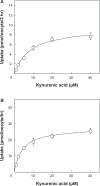Transport of Kynurenic Acid by Rat Organic Anion Transporters rOAT1 and rOAT3: Species Difference between Human and Rat in OAT1
- PMID: 23467467
- PMCID: PMC3576866
- DOI: 10.4137/IJTR.S11206
Transport of Kynurenic Acid by Rat Organic Anion Transporters rOAT1 and rOAT3: Species Difference between Human and Rat in OAT1
Abstract
A tryptophan catabolite, kynurenic acid, is involved in schizophrenia and uremia; there is little information on the mechanism of its disposition. Recently, our laboratory showed that kynurenic acid is a good substrate of human organic anion transporters hOAT1 and hOAT3. In this study, we performed uptake experiment using Xenopus laevis oocytes to characterize the transport of kynurenic acid by rat homologs of the transporters, rOAT1, and rOAT3. These transporters stimulated the uptake of kynurenic acid into oocytes, and transport by rOAT3 was marked. The Km values of the transport were estimated to be 8.46 μM for rOAT1 and 4.81 μM for rOAT3, and these values are comparable to their human homologs. The transport activity of kynurenic acid by rOAT1 was about one quarter of that of p-aminohippurate, although they were at the similar levels in hOAT1. A comparative experiment with hOAT1 was added in this study, showing that uptake amounts of kynurenic acid by hOAT1-expressing oocytes were 4 times greater than rOAT1-expressing oocytes. rOAT3 transported kynurenic acid as efficiently as estrone sulfate; this phenomenon was also observed in hOAT3. In conclusion, transport of kynurenic acid by rOAT1 and rOAT3 was shown. The characteristics of rOAT3 were similar to hOAT3, but low transport activity of kynurenic acid by rOAT1 was exhibited compared with hOAT1.
Keywords: OAT1; OAT3; kynurenic acid; species difference; transport.
Figures



References
-
- Stone TW. Neuropharmacology of quinolinic and kynurenic acids. Pharmacol Rev. 1993;45:309–79. - PubMed
-
- Schwarcz R, Pellicciari R. Manipulation of brain kynurenines: glial targets, neuronal effects, and clinical opportunities. J Pharmacol Exp Ther. 2002;303:1–10. - PubMed
-
- Javitt DC, Zukin SR. Recent advances in the phencyclidine model of schizophrenia. Am J Psychiatry. 1991;148:1301–8. - PubMed
-
- Adler CM, Malhotra AK, Elman I, et al. Comparison of ketamine-induced thought disorder in healthy volunteers and thought disorder in schizophrenia. Am J Psychiatry. 1999;156:1646–9. - PubMed
-
- Schwarcz R, Rassoulpour A, Wu HQ, Medoff D, Tamminga CA, Roberts RC. Increased cortical kynurenate content in schizophrenia. Biol Psychiatry. 2001;50:521–30. - PubMed
LinkOut - more resources
Full Text Sources
Other Literature Sources

